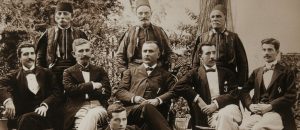The diplomatic gifts found in the collections of Dolmabahçe Palace, sent to the Ottoman Sultans by foreign rulers, are concrete and invaluable historical documents describing the complex international relations, alliances, and rivalries of the 19th century. These gifts were not merely demonstrations of generosity; they were carefully selected political messages reflecting the sending country’s power, artistic level, and the importance it placed on the Ottoman State. From Queen Victoria’s massive chandelier [Link: Kraliçe Victoria’nın dev avizesinden -> /diplomasinin-kristalleri-dolmabahcenin-avize-ve-samdan-koleksiyonunun-dunyaya-gonderdigi-isiltili-mesajlar] to the Russian Tsar’s malachite vases, these treasures have transformed Dolmabahçe into a museum showcasing a history of diplomacy written with gifts. [Link: Dolmahçe Sarayı Koleksiyonları -> /explore/palace-collections]
Why is a Gift a Tool of Diplomacy?
Throughout history, gift-giving has been one of the most fundamental elements of interstate relations. In 19th-century diplomacy, the meanings carried by a gift were multi-layered:
- Respect and Recognition: A sovereign sending a gift to another was a sign of recognizing their sovereignty and legitimacy.
- Message of Alliance: The size and value of the gift symbolized the strength and importance of the alliance between the two countries. Gifts sent especially after accession to the throne (cülus) or an important victory reinforced this friendship.
Display of Power and Prestige:
A gift was also an exhibition of the sending country’s technological, artistic, and economic power. A complicated clock, a gigantic vase, or an object adorned with precious stones conveyed the message, “We are a powerful country capable of making products of this quality“.
- Subtle Political Messages: The gift itself could sometimes contain subtle political messages. For example, a maritime nation gifting a model ship.
Dolmabahçe Palace was one of the most important stages for this dazzling diplomatic game.
Prominent Diplomatic Treasures of the Collection
Dolmabahçe Palace’s collection holds many significant gifts reflecting the relationship of 19th-century superpowers with the Ottoman Empire.
England: Grand Gestures of the Strategic Ally
- Queen Victoria’s Chandelier: Undoubtedly the most famous diplomatic gift, this 4.5-ton crystal chandelier is the brightest symbol of the alliance during the Crimean War and the strategic partnership between the two empires.
- English Silvers and Clocks: British monarchs often gifted the Ottoman Sultans elegantly engraved silver dinner sets and table clocks [Link: masa saatleri -> /zamanin-efendileri-dolmahcenin-saat-koleksiyonu-batililasmanin-tik-tak-sesleridir] with extremely precise mechanisms. These were gifts that emphasized Britain’s superiority in industrial production and mechanical technology.
Russia: The Rival’s Dazzling Gifts
Even Russia, the Ottoman Empire’s greatest rival, sent impressive gifts to keep diplomatic relations warm during periods of peace.
- Malachite and Lapis Lazuli Vases: The gigantic vases sent by the Russian Tsars, covered with semi-precious malachite extracted from the Ural Mountains and lapis lazuli from Afghanistan, were dazzling gifts showcasing the vast natural resources and wealth of the Russian Empire. These vases, standing on either side of the fireplace in the Muayede Hall, demonstrate how even a rival power was represented in the most honored corner of the palace.
- Bear Hides: The enormous bear hides gifted by the Russian Tsars, originating from Siberia, both symbolized Russia’s wild and vast nature and served as a traditional display of power.
France: Gifts of Elegance and Art
France has always conducted diplomacy through art and elegance.
- Sèvres Vases and Porcelains: French emperors gifted gigantic vases and dinner sets specially produced at the Sèvres Factory [Link: Sèvres Fabrikası’nda -> /sultan-sofrasinin-zarafeti-paris-sikligini-dolmabahceye-tasiyan-sevres-ve-baccarat-yemek-takimlari], the world’s most prestigious porcelain. These often depicted scenes from the Napoleonic era or mythological figures, serving as an expression of France’s cultural superiority.
- Gobelin Tapestries: Large-sized wall hangings woven in famous French Gobelin workshops were also among the frequently sent gifts.
Conclusion: The Embodiment of Diplomacy History
In conclusion, the Dolmabahçe Palace diplomatic gift collection is an invaluable treasure where abstract political relations and alliances become concrete, aesthetic, and tangible. Every vase, every chandelier, every clock whispers messages of friendship, rivalry, admiration, and displays of power that once traveled between empires. These works are not merely art objects, but pages of the complex history of 19th-century diplomacy, written in the glittering language of gifts.















